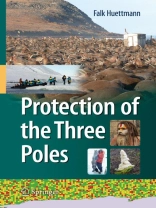The Arctic, the Antarctic, and the Hindu Kush-Himalayas form a trio of terrains sometimes called “the three poles”. Mainly composed of rock, snow, and ice, these precious regions, which are home to many unique species such as the polar bear, the emperor penguin, and the snow leopard, contain the primary water resource of this planet and directly shape our climate. This book presents a first-ever global assessment and progressive review of the three poles and demonstrates the urgent need for their protection. Sins of the past have irrevocably harmed and threatened many of the unique qualities of these regions, and the future looks bleak with the global population forecast to reach 9 billion by 2060, and with climate change on the rise. Presented here is a wide-reaching and coherent overview of the three poles’ biodiversity, habitats, and ongoing destruction. Failed protection and social targets set by the United Nations and other bodies are exposed while economic growth, unconstrained or inappropriate development, and urban sprawl are promoted unabated. Polar regions play a major role in the global agenda as they are rich in oil and other resources, marking them for contamination, overfishing, and further degradation. Tourism in the Antarctic has benefited from enlightened self-regulation, but there are signs that this is changing, too. The chapters of this book are written by experts in their fields, and their evidence leaves no doubt that we already live beyond our carrying capacity on a finite but decaying space. A global protection role model and several outlook scenarios are proposed to help set in motion polar protection priorities that are actually valid. Humanity has demonstrated through international treaties such as the Antarctic Treaty and the Madrid Protocol that we can put the interests of the planet as a whole first. This must become the norm, not the exception.
Table des matières
Part I Introduction.
.- 1 Introduction: Why Three Poles and Why Protect Them? .- Falk Huettmann.
.- Part II Polar Overview.
.- 2 IPY 2007–2008: Where Threads of the Double Helix and Sputnik Intertwine. .- David J. Carlson.
.- Part III The Antarctic.
.- 3 Unnatural Selection of Antarctic Toothfish in the Ross Sea, Antarctica. .- David G. Ainley, Cassandra M. Brooks, Joseph T. Eastman, and Melanie Massaro.
.- 4 Protection of Wilderness and Aesthetic Values in Antarctica. .- Rupert Summerson.
.- Part IV The Hindu Kush–Himalayas.
.- 5 Real World Protection for the “Third Pole” and Its People. .- Nakul Chettri, Arun B. Shrestha, Yan Zhaoli, Birendra Bajracharya, Eklabya Sharma, and Hua Ouyang.
.- 6 Mining the Himalayan Uplands Plant Database for a Conservation Baseline Using the Public GMBA Webportal. .- Dirk Nemitz, Falk Huettmann, Eva M. Spehn, and W. Bernhard Dickoré.
.- Part V The Arctic.
.- 7 Community-Based Surveys and Management of Walruses and Polar Bears in the Area of Cape Kozhevnikov (Chukotka, Russia) . .- Andrei Boltunov, Viktor Nikiforov, and Varvara Semenova.
.- 8 Toward the New Role of Marine and Coastal Protected Areas in the Arctic: The Russian Case. .- Vassily Spiridonov, Maria Gavrilo, Yury Krasnov, Anton Makarov, Natalia Nikolaeva, Ludmila Sergienko, Andrei Popov, and Elena Krasnova.
.- 9 Status, Threat, and Protection of Arctic Waterbirds. .- Christoph Zöckler.
.- 10 Global Issues for, and Profiles of, Arctic Seabird Protection: Effects of Big Oil, New Shipping Lanes, Shifting Baselines, and Climate Change. .- Grant R.W. Humphries and Falk Huettmann.
.- 11 Polar Diseases and Parasites: A Conservation Paradigm Shift. .- Susan J. Kutz.
.- Part VI Synthesis.
.- 12 Yet Another, But This Time Realistic, Polar Synthesis, Meta-Analysis, and Outlook: Protecting Ice, Snow, People, Species, Habitats, and Global Temperatures for Good? .- Falk Huettmann.
.- Epilogue.
.- Index.












